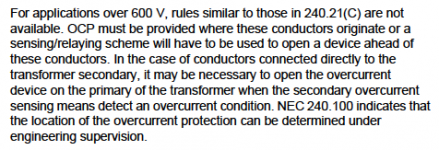xptpcrewx
Power System Engineer
- Location
- Las Vegas, Nevada, USA
- Occupation
- Licensed Electrical Engineer, Licensed Electrical Contractor, Certified Master Electrician
Trying to get some clarity on transformer protection for situations where there is a circuit breaker installed on the primary side, no circuit breaker or fuse on the secondary side, but CT sensing on the primary and secondary configured to trip the primary circuit breaker. Which NEC rules apply here and is this considered both primary and secondary protection even though the disconnecting means is on the primary feeder only? Thanks in advance.

